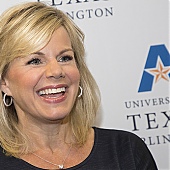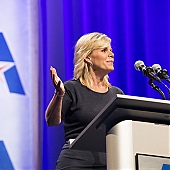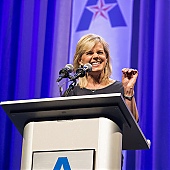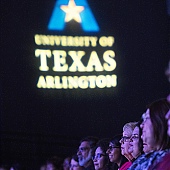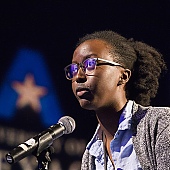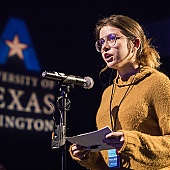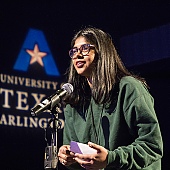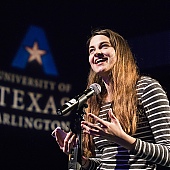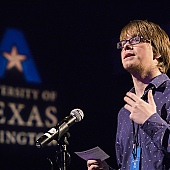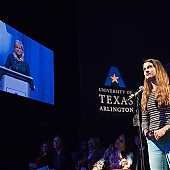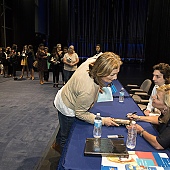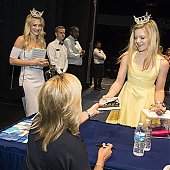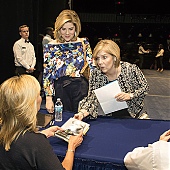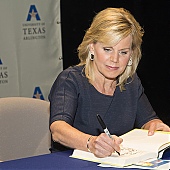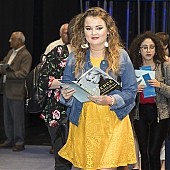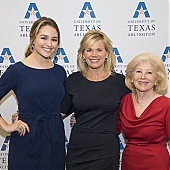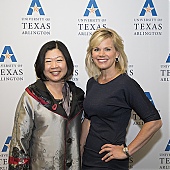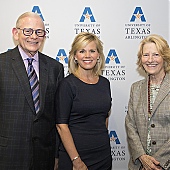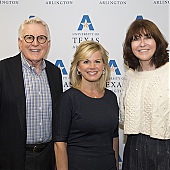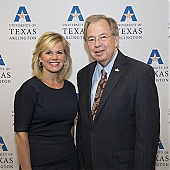
World Class
With their quality, convenience, and breadth, UT Arlington’s award-winning online learning programs are attracting record numbers of students—from as far away as Japan and Kenya and as nearby as campus residence halls.
· Summer 2011 · Comment ·
Leslie “Tinkie” Williams’ first visit to UT Arlington was the day she walked across the Texas Hall stage at commencement. Like a growing number of students, the Tyler nurse earned her degree at her laptop, taking advantage of the University’s distance education offerings.
These online programs let individuals complete a course or finish a degree at their convenience, without family or work conflicts or the hassle of finding a parking space. About 300 UT Arlington instructors teach 700 different classes—from core courses to degree and certification programs—to students who may live halfway around the world or quite possibly across the street. In spring 2011 nearly 6,000 students had fully online schedules.
UT Arlington distance education offerings enrolled a record 22,443 in fall 2010, a boom from the 5,072 enrollments in fall 2009. According to the 2010 Sloan Survey of Online Learning, almost 5.6 million U.S. students took at least one online course in fall 2009, about a million more than fall 2008.
FROM RADICAL TO RANKED
Correspondence courses offered by individual teachers started as early as 1728. The Chautauqua Correspondence Institute in New York opened for classes in 1883. Today’s programs rely on technology instead of the mail carrier. In 1997—when the Internet was young and delivery options were limited—UT Arlington’s new Center for Distance Education launched its first class, Political Science 2311, taught by Michael Moore, then a political science assistant professor.
“We said early on that we would have classes via the Web,” says academic affairs Assistant Vice President Pete Smith, who oversees the Center for Distance Education. “In 1997 that was radical.”
“Flexibility is definitely a positive, probably the biggest one in my mind. You aren’t tied down by geography or a class schedule.”
Since then, UT Arlington has remained at the forefront, with programs garnering accolades such as Best in Nation from U.S. News & World Report and professors receiving four consecutive U.S. Distance Learning Association (USDLA) awards for quality, the only institution so honored.
As a leader in the UT System, the state, and the nation, the University continues defining and refining distance education. This year President James D. Spaniolo was named to the UT System’s new Task Force on Blended and Online Learning, and he and Dr. Smith have served on the Association of Public and Land-grant Universities/Sloan National Commission on Distance Education.
“We are committed to improving the quality of our academic programs, both in traditional classroom settings and through an array of online courses designed to deliver education where people live and work,” Spaniolo says.
NEAR AND FAR
Distance learners include students who can’t attend a class because of work, professionals wanting to advance their careers, soldiers overseas, and international students who may want to listen to a lecture two or three times. Online courses are great for the at-home mom or dad, a traveling business executive, a busy nurse or teacher, a high school senior seeking dual credit, or one of the estimated 3.5 million Texans who didn’t finish college as a young adult.
The courses were ideal for Scott Cunningham and Karen Elliott, who put the distance in distance education.
WORLDWIDE REACH
Karen Elliott ’11 reads to children at the Rafiki Village in Zambia. She worked on her Master of Education degree during frequent trips to Africa.
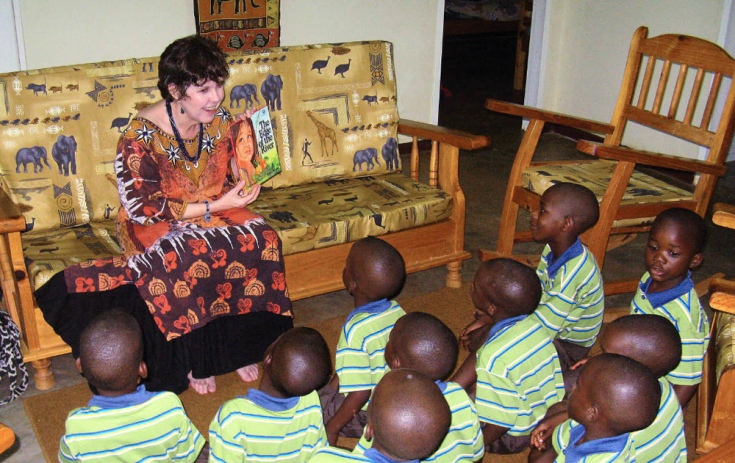
Cunningham lived in Dallas in 2005 when he started taking graduate education courses. The Nigerian native had a bachelor’s degree in English from Texas A&M and chose UT Arlington’s program for its affordability and accessibility. Personal business took him to Bolivia, where he completed a secondary certification program through the College of Education and Health Professions.
“I chose the distance ed program because I wanted to be overseas and teaching as soon as possible,” the 29-year-old says. “Flexibility is definitely a positive, probably the biggest one in my mind. You aren’t tied down by geography or a class schedule.”
Cunningham says he loves teaching English at Highlands International School in La Paz, Bolivia, and plans to finish a master’s degree in educational leadership online in the future.
Elliott wanted formal instruction in teaching after 10 years with the Florida-based Rafiki Foundation, a nonprofit ministry with orphanages and vocational training centers in 10 African countries, including Kenya, Zambia, and Tanzania. As director of Africa operations, she oversees schools and residential centers.
“I wanted something more than an administrative degree in education,” says Elliott, who completed a Master of Education degree in curriculum and literacy studies in May. “I really wanted to learn how students at elementary and secondary levels learn. I wanted to focus on literacy, so this program fit the bill.
“I travel a lot—three times a year to Africa for two to three weeks at a time—so I needed a program that would let me work on the degree from a distance.”
Closer to campus, in Tyler, Texas, Tinkie Williams put her plans for a Bachelor of Science in Nursing on hold in the mid-1990s when she had a daughter and her mother was sick.
“It was one thing after another, then I started a business,” she says. “I turned around and 10 more years had passed. So finally I said, ‘I have to do this.’ ”
Her sister, Liz Goodman, also a registered nurse, told Williams about the online RN-to-BSN program offered by UT Arlington’s College of Nursing and challenged her to enroll. The sisters signed up but were in different cohorts, or student groups.
“My daughter was in eighth grade when I started, and I graduated in the middle of her ninth-grade year. I helped her with biology, and she helped me with algebra,” Williams recalls. “Many nights I was working all night long in my pajamas. I do better when working independently.”
The hard work paid off, with Williams graduating summa cum laude in December 2010. Goodman graduated in May.
On-campus students like public relations sophomore Zack Minter also benefit from online classes. He took microeconomics from Professor Ryan Amacher in spring 2011.
“I had four regular classes and didn’t want to be in a classroom more than that,” says Minter, who is a resident assistant at Pecan Place Apartments and works at the New Student Welcome Center. “With work, I would be busy from 8 a.m. to 8 p.m. This way I could study at my leisure and during the weekends.”
He praised Dr. Amacher for sending frequent emails to students, often suggesting a schedule for completing assignments. Minter plans to take more online classes to reach his goal of graduating in May 2013.
REMOTE CONTROL
Graduate student Stacey McKendry ’07, left, takes online courses as a resident assistant in Arlington Hall.
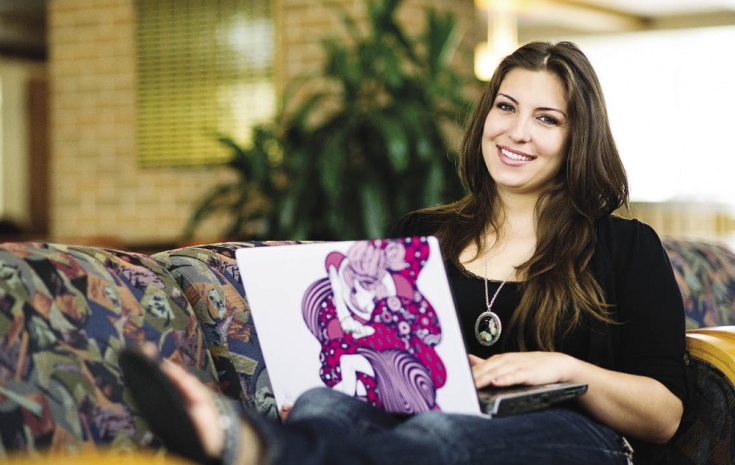
PERSONAL TOUCH
Technology plays a role, but it’s the instructors who define distance programs.
“One thing that sets UT Arlington apart is that we have invested very heavily in our Center for Distance Education,” says Dr. Moore, now senior vice provost and dean of undergraduate studies and the recipient of a 2010 USDLA Gold Best Practices Award of Excellence. “Student support specialists and instructional designers work with the faculty to create high-quality courses that are innovative and make the best use of technology.
“The faculty who are engaged in this are some of our best instructors. We’ve really relied on some of our best tenured and tenure-track faculty.”
One of those is Nancy Hadaway, director of the literacy and secondary education programs for the College of Education and Health Professions and a member of UT Arlington’s Academy of Distinguished Teachers. She taught her first online class in 1999.
“When I went into it, it didn’t register with me that I wouldn’t be face to face. It took some getting used to,” says Dr. Hadaway, who now teaches only online courses. “When you reach out to students, you can have a voice so they can see you as a person.”
Elliott took several of Hadaway’s courses.
“She was great to work with,” Elliott says. “She was very accessible and responsive to any question I had. I wish I could come for graduation; I’d love to meet her face to face.”
Hadaway learns from her students as well.
“Student support specialists and instructional designers work with the faculty to create high-quality courses that are innovative and make the best use of technology.”
“I have students in Japan, Saudi Arabia, and Germany, as well as military spouses and people in American schools overseas and the United States. Classes feature very rich give-and-take discussions.”
Enrollment in the College of Nursing and the College of Education and Health Professions has increased dramatically in recent years due, in part, to agreements with Academic Partnerships, a Dallas-based company that provides marketing support and other e-learning services for select UT Arlington programs.
About 5,000 students have taken Moore’s political science class in the past 15 years, and he enjoys when a former online student recognizes him and says hello. On the technology front, he says online teaching is much better than that first class in 1997 when time-consuming, edited videos of classroom lectures were the norm.
Now instructors can choose from various formats that meet their needs and those of their students. Blackboard is a learning management system that allows faculty to teach and students to learn online, incorporating such features as online presentations, discussion areas, and communications tools. Blogs, discussion boards, and Skype sessions are other common avenues.
A class can be taught using only text, or with live video of the professor, or through a virtual hands-on world. The College of Nursing uses Second Life—an online 3-D virtual world—to re-create medical scenes and scenarios.
With these new classrooms come changes in teaching styles, but the basic components of a political science, freshman English, or graduate business course remain the same.
“Even though it’s not a physical class that meets, you have to make time for it. Class will go on whether you’re there or not,” says Stacey McKendry, a graduate student in educational leadership and policy studies and a resident assistant in Arlington Hall.
University services are an integral part of learning, Smith says. The library, advising, and Career Center are among the programs available to online students. Williams ordered books online through the UT Arlington Bookstore and used interlibrary loans. Students who take the 74 online English classes—mostly freshman and sophomore level—each year have access to the Writing Center’s services and can call, email, or participate in Skype sessions with center personnel.
Leslie “Tinkie” Williams ’10, left, and her sister, Liz Goodman ’11, earned nursing degrees online while living in East Texas.
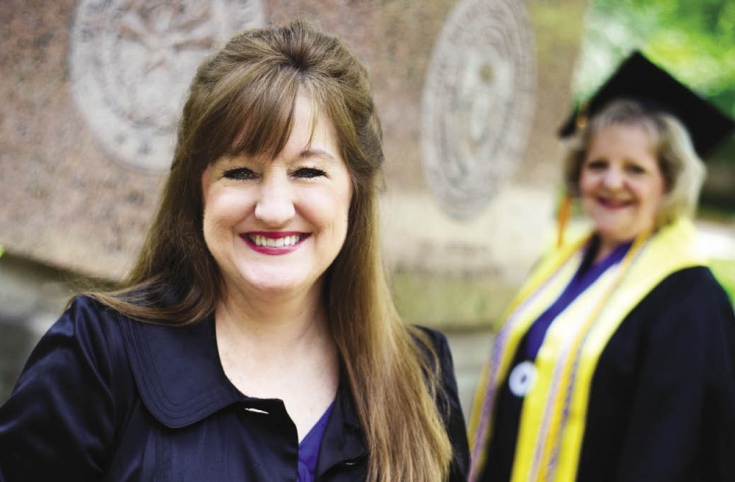
VIRTUAL GRADUATION
Williams arrived for her graduation last December not sure if she’d meet her online cohorts.
“We were all there at 6 p.m. and we went in at 7, trying to get in order,” she recalls. “They put us in alphabetical order and you could start telling who was who. I saw a few walk across the stage.
“The camaraderie and pride from all the work, the cap and gown, the calling of your name. These are the moments when the hard work pays off. It was so intense for so long. It was kind of surreal.”
Her diploma looks the same as those for students who attend classes in brick and mortar buildings. A UT Arlington degree represents quality, whether earned online or in person.
“It won’t be long,” Smith says, “before we have a virtual graduation for those who can’t attend.”
